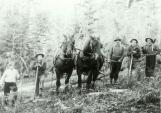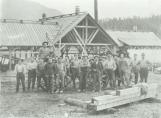1
Individuals and small logging contractors could obtain contracts from the Canadian Pacific Railway as well as individuals to cut railway ties, cordwood and fence posts. Timber was cut from stands of trees being cleared from farmland, private or forestry timber sales.
In the early days of the paddle steamers and steam trains, many homesteaders earned income by providing cordwood which was burned for fuel.
2
Hauling logs by sleigh
c.1908-1940
Turtle Valley, British Columbia, Canada

3
Hand-hewn fir railway ties were produced for the Canadian Pacific Railway and shipped across Canada.
4
Wooden ties on beach
c.1900-1925
Adams Lake Area, British Columbia, Canada

5
Horse pulling a load of railway ties
1900-1925
Chase/Shuswap Area, British Columbia, Canada

6
Initially all cutting and loading was done manually. Horses were used for skidding and hauling the logs to portable sawmills.
7
Sawing logs
c1936-1950
Chase/Shuswap Area, British Columbia, Canada

8
Skidding with horses
1908-1925
Adams Lake Area, British Columbia, Canada

9
As portable sawmills and logging equipment became readily available, contractors could also produce custom sawed timbers. An efficient enterprise could employ 10 men.
10
Turtle Valley Lumber Mill
1900-1950
Turtle Valley, British Columbia, Canada

11
In later years most small contractors were bought out by large sawmill operations.





